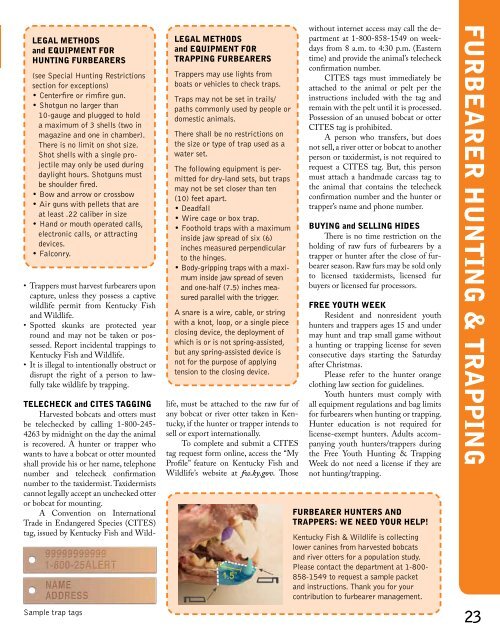Create successful ePaper yourself
Turn your PDF publications into a flip-book with our unique Google optimized e-Paper software.
LEGAL METHODS<br />
and EQUIPMENT FOR<br />
HUNTING FURBEARERS<br />
(see Special Hunting Restrictions<br />
section for exceptions)<br />
• Centerfire or rimfire gun.<br />
• Shotgun no larger than<br />
10-gauge and plugged to hold<br />
a maximum of 3 shells (two in<br />
magazine and one in chamber).<br />
There is no limit on shot size.<br />
Shot shells with a single projectile<br />
may only be used during<br />
daylight hours. Shotguns must<br />
be shoulder fired.<br />
• Bow and arrow or crossbow<br />
• Air guns with pellets that are<br />
at least .22 caliber in size<br />
• Hand or mouth operated calls,<br />
electronic calls, or attracting<br />
devices.<br />
• Falconry.<br />
• Trappers must harvest furbearers upon<br />
capture, unless they possess a captive<br />
wildlife permit from Kentucky Fish<br />
and Wildlife.<br />
• Spotted skunks are protected year<br />
round and may not be taken or possessed.<br />
Report incidental trappings to<br />
Kentucky Fish and Wildlife.<br />
• It is illegal to intentionally obstruct or<br />
disrupt the right of a person to lawfully<br />
take wildlife by trapping.<br />
Sample trap tags<br />
LEGAL METHODS<br />
and EQUIPMENT FOR<br />
<strong>TRAPPING</strong> FURBEARERS<br />
Trappers may use lights from<br />
boats or vehicles to check traps.<br />
Traps may not be set in trails/<br />
paths commonly used by people or<br />
domestic animals.<br />
There shall be no restrictions on<br />
the size or type of trap used as a<br />
water set.<br />
The following equipment is permitted<br />
for dry-land sets, but traps<br />
may not be set closer than ten<br />
(10) feet apart.<br />
• Deadfall<br />
• Wire cage or box trap.<br />
• Foothold traps with a maximum<br />
inside jaw spread of six (6)<br />
inches measured perpendicular<br />
to the hinges.<br />
• Body-gripping traps with a maximum<br />
inside jaw spread of seven<br />
and one-half (7.5) inches measured<br />
parallel with the trigger.<br />
A snare is a wire, cable, or string<br />
with a knot, loop, or a single piece<br />
closing device, the deployment of<br />
which is or is not spring-assisted,<br />
but any spring-assisted device is<br />
not for the purpose of applying<br />
tension to the closing device.<br />
TELECHECK and CITES TAGGING<br />
Harvested bobcats and otters must<br />
be telechecked by calling 1-800-245-<br />
4263 by midnight on the day the animal<br />
is recovered. A hunter or trapper who<br />
wants to have a bobcat or otter mounted<br />
shall provide his or her name, telephone<br />
number and telecheck confirmation<br />
number to the taxidermist. Taxidermists<br />
cannot legally accept an unchecked otter<br />
or bobcat for mounting.<br />
A Convention on International<br />
Trade in Endangered Species (CITES)<br />
tag, issued by Kentucky Fish and Wildlife,<br />
must be attached to the raw fur of<br />
any bobcat or river otter taken in Kentucky,<br />
if the hunter or trapper intends to<br />
sell or export internationally.<br />
To complete and submit a CITES<br />
tag request form online, access the “My<br />
Profile” feature on Kentucky Fish and<br />
Wildlife’s website at fw.ky.gov. Those<br />
without internet access may call the department<br />
at 1-800-858-1549 on weekdays<br />
from 8 a.m. to 4:30 p.m. (Eastern<br />
time) and provide the animal’s telecheck<br />
confirmation number.<br />
CITES tags must immediately be<br />
attached to the animal or pelt per the<br />
instructions included with the tag and<br />
remain with the pelt until it is processed.<br />
Possession of an unused bobcat or otter<br />
CITES tag is prohibited.<br />
A person who transfers, but does<br />
not sell, a river otter or bobcat to another<br />
person or taxidermist, is not required to<br />
request a CITES tag. But, this person<br />
must attach a handmade carcass tag to<br />
the animal that contains the telecheck<br />
confirmation number and the hunter or<br />
trapper’s name and phone number.<br />
BUYING and SELLING HIDES<br />
There is no time restriction on the<br />
holding of raw furs of furbearers by a<br />
trapper or hunter after the close of furbearer<br />
season. Raw furs may be sold only<br />
to licensed taxidermists, licensed fur<br />
buyers or licensed fur processors.<br />
FREE YOUTH WEEK<br />
Resident and nonresident youth<br />
hunters and trappers ages 15 and under<br />
may hunt and trap small game without<br />
a hunting or trapping license for seven<br />
consecutive days starting the Saturday<br />
after Christmas.<br />
Please refer to the hunter orange<br />
clothing law section for guidelines.<br />
Youth hunters must comply with<br />
all equipment regulations and bag limits<br />
for furbearers when hunting or trapping.<br />
Hunter education is not required for<br />
license-exempt hunters. Adults accompanying<br />
youth hunters/trappers during<br />
the Free Youth Hunting & Trapping<br />
Week do not need a license if they are<br />
not hunting/trapping.<br />
FURBEARER HUNTERS AND<br />
TRAPPERS: WE NEED YOUR HELP!<br />
Kentucky Fish & Wildlife is collecting<br />
lower canines from harvested bobcats<br />
and river otters for a population study.<br />
Please contact the department at 1-800-<br />
858-1549 to request a sample packet<br />
and instructions. Thank you for your<br />
contribution to furbearer management.<br />
FURBEARER HUNTING & <strong>TRAPPING</strong><br />
23


